This Shao Bing recipe is one of my mom’s best known recipes that she used to make for my dad. These little biscuits are filled with savory stir fries or meats.
Today, I have a very special recipe to share with you, so please indulge me.
Although my parents immigrated to the United States over 50 years ago, they still love their Chinese food more than any other cuisine – authentic Chinese food that is. We’re not talking about Chinese take-out. We’re talking about food that you won’t find in most Chinese restaurants, and in the case of these Beijing Biscuits or Shao Bing that I’m sharing today, you probably can’t find these anywhere in the United States, unless you have a mom who knows how to make them like mine or you make them yourself.
[rss-cut]
My dad is from Beijing, and although he left China when he was a teenager, he never forgot his favorite foods as a child. Over the years, my mom worked to recreate some of my dad’s favorite foods from his childhood memories of what his favorite foods looked and tasted like. Not an easy task, especially since my mom is from a completely different province in China and was unfamiliar with these foods.
The recipe I’m sharing today is a very special one – one that my mom has refined over many years and perfected (including making them healthier by using some whole wheat flour). It has the shape, size, taste and all the layers that my dad so fondly remembers. In fact, a friend of my mom’s who tasted the real thing in Beijing gave her the ultimate compliment when she said her homemade Shao Bing tasted just like what she had in China.
My mom and I spoke by phone a few weeks ago about these Beijing Biscuits (as my refers to them) or Shao Bing, and how she was trying to teach her caregiver to make them, but how inconsistently they were coming out. Apparently, the bings were coming out all different shapes and sizes, and the sesame seeds were not sticking to the tops of the bings (she did not listen to my mom’s detailed instructions about using egg white to make the sesame seeds stick). So, I took up the challenge of trying to make Shao Bing at home, hoping to ship off a batch to my folks for their approval.
My first attempt at making Shao Bing resulted in oversized buns that were more like hamburger rolls than bings. I eagerly shipped off my hard work to my parents (they took all afternoon to make), only to be told by my mom that they did not look or taste like the real Beijing Shao Bing (sorry, Ming Tsai, I usually love your recipes, but your recipe was way too complicated, took me all afternoon to make, and didn’t pass the taste test from my parents). Although they tasted great (at least I liked them), my buns were not the right texture (they were denser), nor were they the right shape or size (not flat enough and way too big).
So, my mom, who by the way is nearly blind (which makes this all the more remarkable), spent a day making her own batch of Shao Bing, wrote the recipe down for me, and shipped them off to me. Sure enough, my mom’s bings were much smaller and flatter than mine, and had nice layers of dough inside.
Beijing Shao Bing (北京燒餅) is considered a common snack food in Beijing, sold on the streets everywhere. All you have to do is google it and you’ll find images of what these little bings look like. Bing in Chinese refers to any kind of flat bread, so scallion pancakes are a type of bing as are these biscuit like buns called Shao Bing.
What makes Shao Bing special are all all the layers inside, separated by sesame paste and in this case, a sprinkling of ground roasted Szechwan peppercorns and salt.
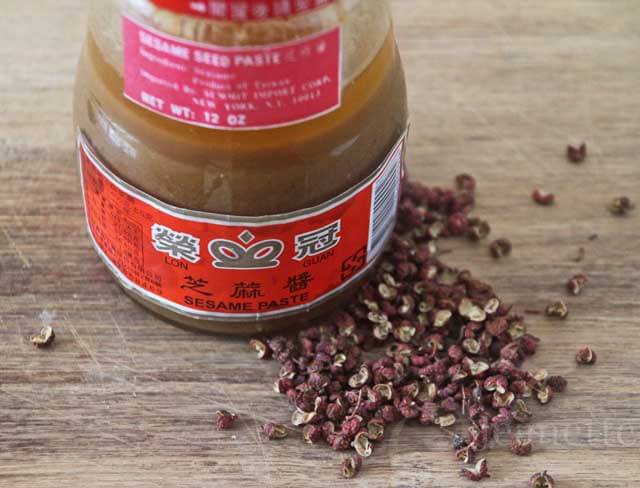
Sesame Paste and Szechuan Peppercorns
The tops are coated with a layer of sesame seeds, although from what I gather, you can also buy these bing in Beijing without sesame seeds on top.
Shao Bing are commonly eaten for breakfast with soy milk or tea, as well as with hot pot. Although shao bing can be eaten as is, they are often stuffed with assorted fillings, some sweet, some savory. Sweet fillings might include red bean paste, black sesame paste, or jujube (date) paste. Savory fillings might include Rousong (肉鬆), Char Siu, or a simple stir-fry of ground or shredded meat and vegetables.
This recipe is a family treasure, and I’m recording it here so that my children will have it to pass down. My next challenge will be to try making gluten-free Shao Bing.
Now, I’ll take you step-wise through the process of making these Shao Bing. They are a bit time consuming (especially when you’re making them for the first time, and washing your hands in between each step to take a picture), but with practice, I’m hoping to get better and faster at it.
First, take half the dough and roll it into a 12″ x 14″ rectangle (you will repeat the same steps below for the other half of the dough).
Brush sesame paste (toasted, not tahini) all over the rolled dough.
Sprinkle sesame paste coated dough with ground toasted Szechuan peppercorns and a little salt.
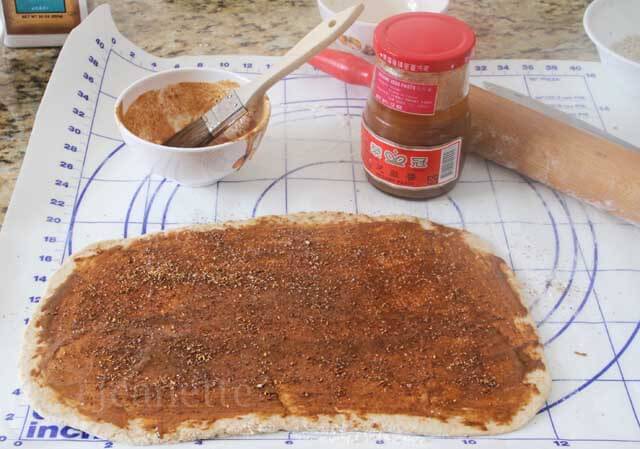
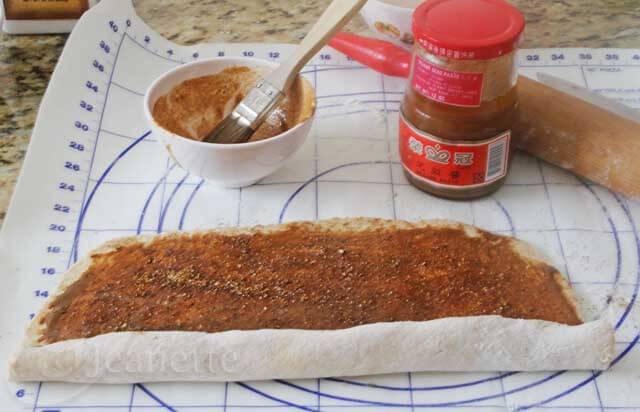
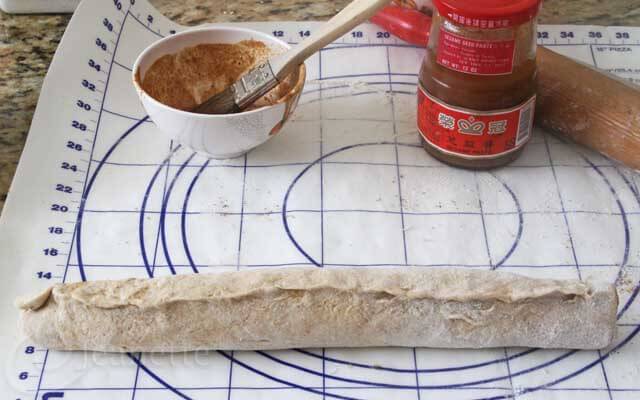
Pinch the open ends together tightly.
Place dough in palm of your hand with with cut edges facing out (you want the dough layers to lay horizontally) and mold dough into round circle, rolling each piece between the palms of your hand.
Press circle flat to about 2 1/2″ in diameter and 1/4″ thick.
Brush tops of each circle lightly with egg wash and press gently in sesame seeds to coat one side.
Set aside and let rise for 30 minutes. Place shao bings sesame seed down on a baking sheet.
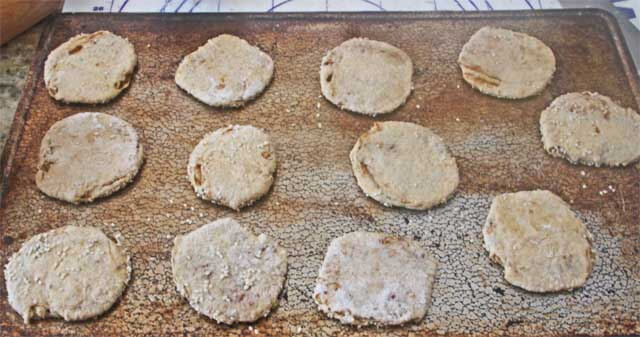

I served my Shao Bing stuffed with Stir-Fry Pressed Bean Curd, Garlic Chives and Bean Sprouts. I’ve also served them stuffed with scrambled eggs and scallions for breakfast. My mom stuffs hers with sliced meats sometimes.
Thanks for the Shao Bing Cooking Lesson Mom! I never realized how much labor went into making these, but now I have a much better understanding and appreciation. I’m so glad I actually made these and chronicled each step so I can refer to this post in the future and pass it down to future generations.
Beijing Biscuit “Shao Bing” (北京燒餅)
Ingredients
Shao Bing Dough
- 1 cup cold water
- 1 tablespoon olive oil
- 1 tablespoon organic sugar
- 1/2 tablespoon yeast
- 1/2 tablespoon baking powder
- 1 1/2 cups all purpose flour
- 1 1/2 cups white whole wheat flour
Shao Bing Spread
- 1/4 cup sesame paste roasted, not tahini
- 1-2 tablespoons sesame oil may not be needed depending on consistency of sesame paste
- 2 teaspoons roasted Szechuan peppercorns ground in a spice grinder
- 1/2 teaspoon salt
Shao Bing Topping
- 1 egg white or 2 teaspoons honey
- 1 teaspoon water
- 1/2 cup raw sesame seeds
Instructions
Shao Bing Dough
-
Place all ingredients except for the flours in a large mixing bowl. Stir well to dissolve sugar. Add the two kinds of flours, alternately, in 1/2 cup portions. Mix and knead well until a soft firm dough forms. Cover and let rise for about 2 hours.
Shao Bing Spread
-
Mix sesame paste with enough sesame oil to make it loose and thin enough to brush on the dough.
Shao Bing Topping
-
Gently beat egg white and mix with water to thin. Alternatively, mix honey and water together. Place sesame seeds in a shallow bowl or on a plate.
Shaping Shao Bing
-
Cut dough in half. Roll one half into a rectangle, about 12"x14". Brush with half of Shao Bing Spread. Sprinkle with roasted Szechuan pepper and salt. Starting with the long end, roll the dough up tightly, jelly-roll style. Seal edges together by pinching dough together along length of dough (use water if necessary). Cut dough into 1 1/2" pieces. Pinch the open ends together tightly. Place dough in palm of your hand with with cut edges facing out (you want the dough layers to lay horizontally). Mold dough into round circle and roll between the palms of your hand. Press circle flat to about 2 1/2" in diameter and 1/4" thick.
-
Brush tops of each circle lightly with egg wash and press gently in sesame seeds to coat one side.
-
Set aside and let rise for 30 minutes.
-
Heat heavy skillet over medium heat. Place biscuits with sesame seed side down. Cover and pan bake for 6 minutes. Turn biscuits over and reduce heat to medium low. Continue to pan bake for 3 minutes. Shao Bing should be slightly browned on both sides. Alternatively, you can bake the Shao Bing in a preheated oven set at 375 degrees with the sesame seed side down for 10 minutes; then turn biscuits over and bake another 5 minutes.
If you like this Shao Bing recipe, you may also like:
Bao Bing (for Moo Shu Shrimp)
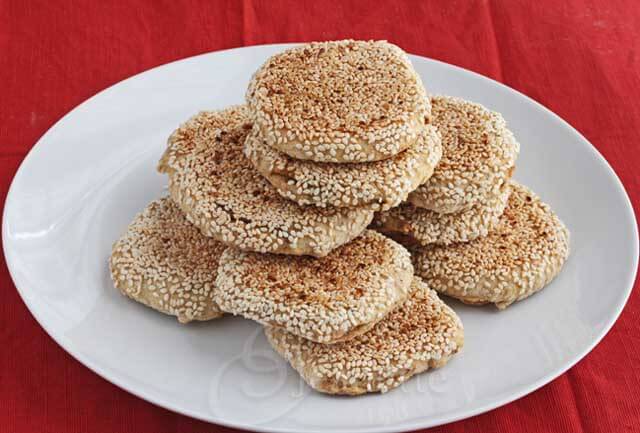
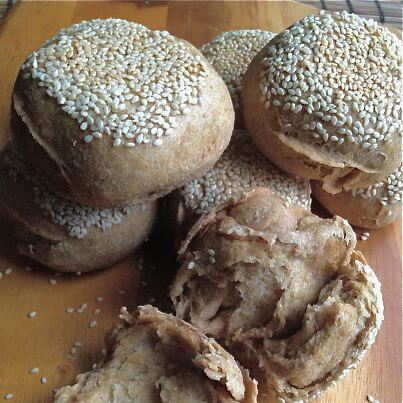
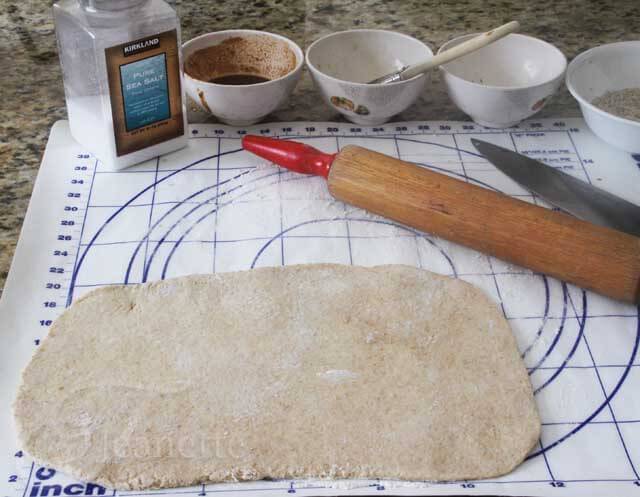
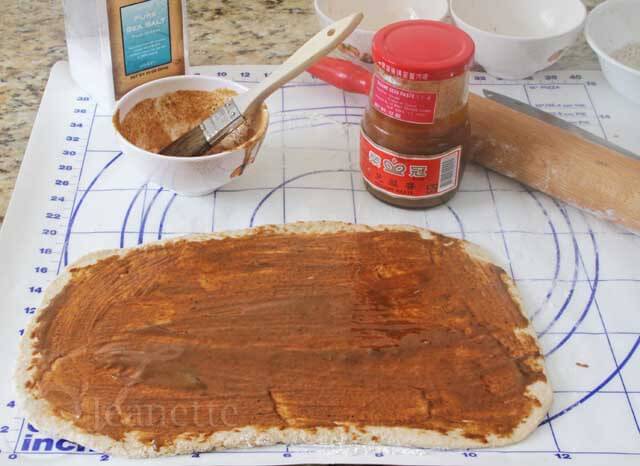
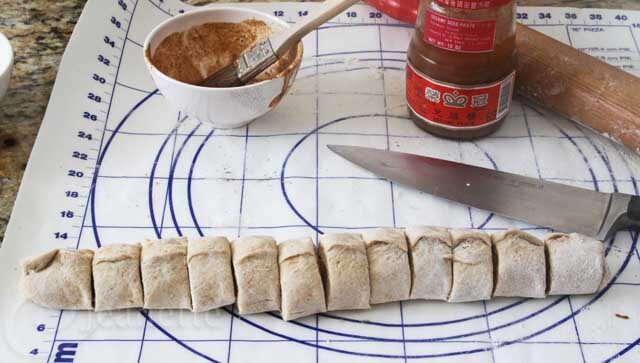
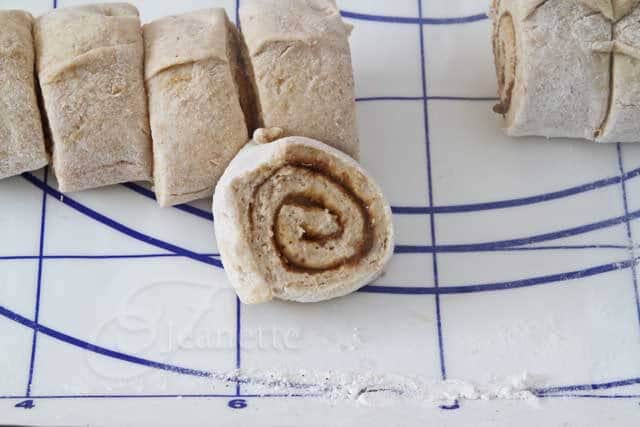
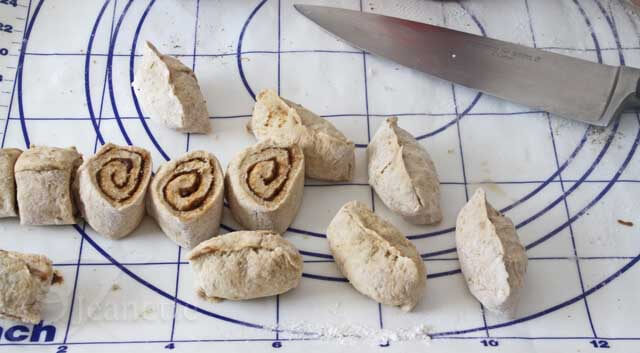

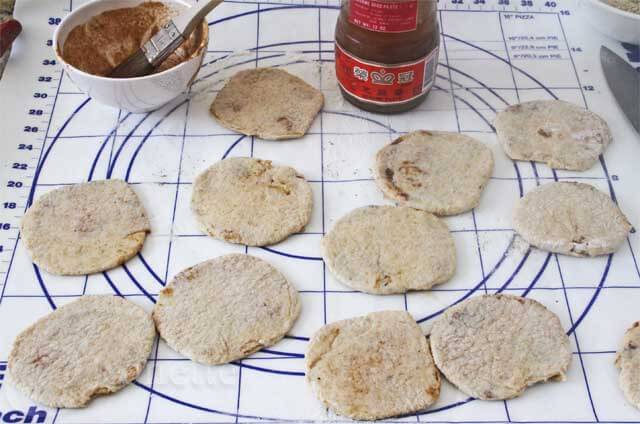
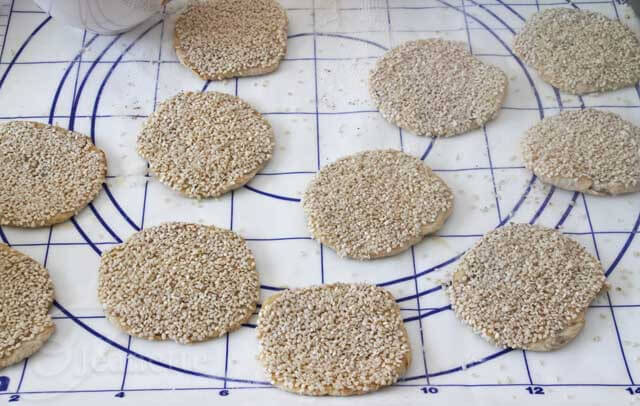
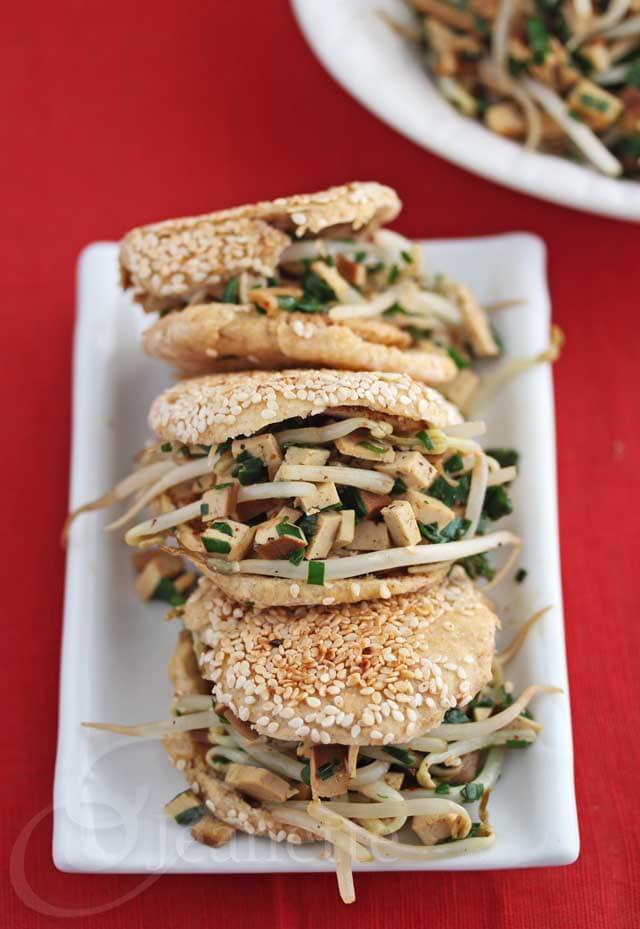
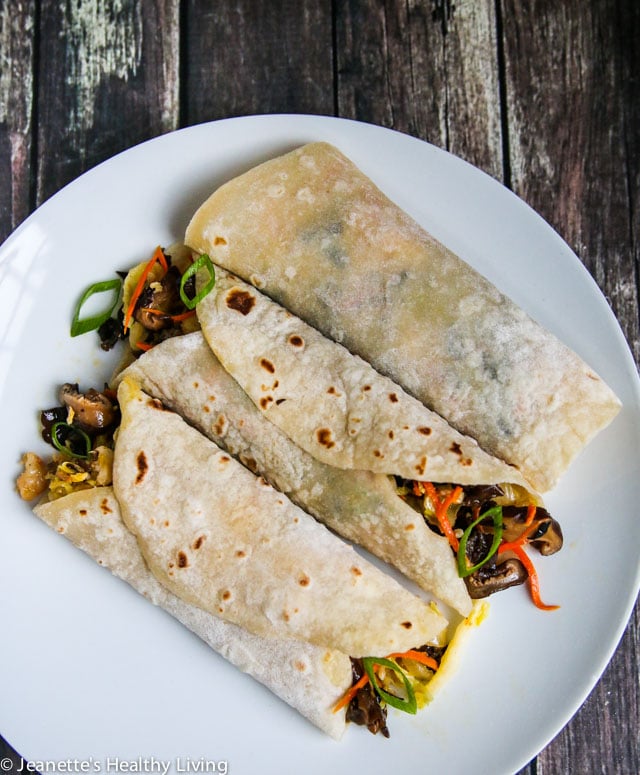
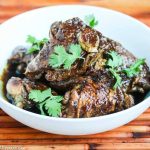

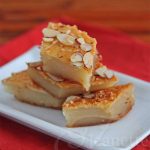





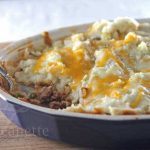

This recipe made me excited for you. I am happy that you have archived the recipe and are making these in your home. Love family traditions. This sounds so delicious. Yummy!
Thanks so much – I’m excited to have the recipe and to have recorded here so I can refer back to it.
Wow, what a treasure indeed! Your mom sounds like an incredible woman. Thank you so much for sharing this recipe…it is something to be cherished and I hope to give it a try in my kitchen!
Thanks Faith – my mom is pretty incredible – she didn’t know how to cook at all when she first got married, so I am amazed by all that she taught herself to make, including these authentic Shao Bing that my dad grew up eating.
These look pretty delicious Jeanette and what a gift to be able to chronicle the recipe from your mom!
Thanks Alyssa – I’m hoping to get more recipes from my mom and record them here on my blog. It’s a great place to keep them so my kids will have them as well.
How lucky your boys will be to have this recipe handed down from their grandmother. And it’s a treat for the rest of us, too.
Thanks everyone – that’s what I love about my blog…I can keep some treasured recipes here for my kids and for me to reference. This is a treasured recipe – not the easiest to execute, but a very special one indeed.
Oh, this recipe and story definitely touched my heart! I am sure many can resonate with the yesteryear stories we all have in regards to mom’s cooking!
cooking family recipes…and passing them down to our children… is one o the most important things we can do. thank you for posting this story.
I agree Diane – it is the one thing that will stay with our children for a very long time.
thank you for sharing this, Jeanette – I loved reading about your parents. Your mom sounds wonderful.
and this recipe sounds wonderful! I might give these a try!
What a special treat to have you share with us such a special recipe. You are so sweet to learn how to make them for your parents too. They look wonderful, but I can see where it’s easy to go wrong.Lots of steps. Thank you for taking all the photos of your steps to save us from making any errors. They look wonderful.
Thanks France! I wish I had learned how to make these sooner. My mom knows how to make them like the back of her hand. For me as a newbie, it was pretty time consuming, so I’m glad I finally tried it and have it recorded on my blog for future reference.
Amazing recipe – and what a cool story to go with it! Thanks for sharing!
I definitely miss shao bing from living in Beijing. Thanks for sharing your family’s recipe. It looks great, and the stuffed version looks like such a delicious, healthy meal.
I’ve never been to Beijing, but hope to one day so I can try some of the street food, including Shao Bing.
LOVE everything about this post. Love family heirloom recipes. Pinning now!
Thanks Laura – I’m trying to collect some of my mom’s special recipes like this one.
Such sentimental recipes I love the most, family traditions I try to keep as you do. This biscuits sound very nice, I ve never heard about them before. Thanks for sharing and bests from Poland!!
Dear Jeanette
The Shao Bing was a hit with my family. Thanx to the pix you posted, I managed to do it all correctly and served it to my family with Hunan Beef with Red & Yellow Peppers in Bangalore, India.
I especially loved the sesame paste to grease the flour. That’s what drew me to your recipe. It worked well both in terms of texture and flavour.
Thanx and peace
Tasqeen
Tasqueen, so glad the Shao Bing worked out well for you and your family. The pictures will help me remember how to make them too 🙂
I had such bings somewhere as a starter and loved it, but never got to catch the name of it, leave alone the actual recipe.
Thank you so much for this, making them will bring back some nice memories and let me share the experience with friends. Lovely site :)!
Daria – this is an heirloom recipe from my mom – hope you enjoy!
Thanks so much for sharing this. I’ve been looking for a not-insanely-complicated (I’m looking at you, Ming Tsai) version since trying them in Beijing years ago.
I hope you enjoy these. I actually tried making Ming Tsai’s version before I tried my mom’s. I think his version is a different kind – my mom said they were not the “right” one – which probably means they’re not the same kind – I’m guessing there are lots of different kinds of bing.
great recipe! I tried making them and they turned out great. I decided to forego the sesame paste (mainly because it’s unavailable where I am) and substituted it with a sugar spread to make sweet shaobing.
The results were spectacular!
Michael – so glad you gave this recipe a try – it’s a fair amount of work, but worth the effort. I was just thinking about making some myself. Like your sweet version. My mom will love it when I tell her you tried her recipe – thank you!
Hi, Jeanette. I am also a immigrant from China. I love the Chinese even if I lived in USA for servral years. By the way, your recipe is very attracive for me. I will try it.
Thanks Mandy – it is my mom’s recipe – hope you enjoy it!
Hi,
SO happy to find this recipe, so planning to make it this weekend. Will let you know, how it went. However, the yeast you are using here is instant yeast or dry active yeast? Thank you,
Hi Kellee – either instant or dry active yeast should work. Hope you enjoy!